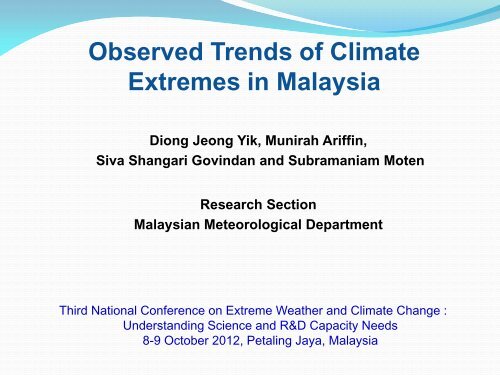Trend - Akademi Sains Malaysia
Trend - Akademi Sains Malaysia
Trend - Akademi Sains Malaysia
You also want an ePaper? Increase the reach of your titles
YUMPU automatically turns print PDFs into web optimized ePapers that Google loves.
INTRODUCTION<strong>Malaysia</strong>n Climate :Temperature – Increasing trend observed in min and ave temp (follows global trend)Rainfall – More Complex<strong>Malaysia</strong>n rainfall – Intense convective rain : duration – few hoursMonsoon rain : duration – few daysPast studies – Manton, M.J., et al. (2001) { 7 stations, 1961 – 1998 }Choi, G., et al., et al (2005) { 4 stations, 1955 -2007 }These studies - used only a few stationslength of record is shortlimited to daily rainfallOther studies - data from auxiliary rainfall stationsdata homogeneity and quality is questionableAbove studies did not address the trends at different times scales
Location of stations used in this study and itsmonthly mean precipitation.
DATA AND METHOD‣ Hourly rainfall data from 22 principal meteorological stations(minimum 30 years of record).‣ The trend analysis cover the periods from 1951 to 2009.‣ The indices and their trends are performed using RClimDex.‣ The regional averaged indices are calculated based on New et. al., 2006‣ The indices are calculated in 3 different time-scale in order to analyzethe trends in extreme events at convective, seasonal and annual timescales.‣ Cumulative hourly totals for 1,2 and 3 hours are examined to studyextreme events trends at the convective time scales.‣ Statistical significant at various levels for the trends are based on theKendall’s tau statistic.
ID INDEX DEFINITIONS UNITRX1 Maximum 1-day rainfall Monthly maximum 1-day rainfall mmRX3 Maximum 3-day rainfall Monthly maximum consecutive 3-dayrainfallRX5 Maximum 5-day rainfall Monthly maximum consecutive 5-dayrainfallSDII Simple daily intensity index Annual total rainfall divided by thenumber of wet days (>1mm) in the yearmmmmmm/daysR10 Number of heavy rainfall days Annual count of days-rainfall≥10mm daysR20 Number of very heavy rainfall days Annual count of days-rainfall≥20mm daysR30R50Number of rainfall days above30mmNumber of rainfall days above50mmAnnual count of days-rainfall≥30mmAnnual count of days-rainfall≥50mmCDD Consecutive dry days Maximum number of consecutive dayswith rainfall95 thpercentileR99 Extremely wet days Annual total rainfall when RR>99 thpercentilePRCPTOT Annual total wet-day rainfall Annual total rainfall in wet days(RR≥1mm)daysdaysdaysdaysmmmmmm
CONVECTIVE TIME SCALE<strong>Trend</strong>s in 2 hour maximum rainfall
Frequency of Heavy Rainfall (blue) (>20mm) &Intensity (red) for 2 Hour Maximum Rainfall.Number in box indicates trends in PRCPTOT.
INDEXDEFINITIONP.M<strong>Trend</strong>E.MRX1 Max 1-Day rainfall 0.06 0.00RX5 Max 5-Day rainfall 0.02 0.08SDII Simple Daily Intensity Index 0.15 * 0.05R10 Annu. count of day rainfall>10mm 0.38 1.48R20 Annu. count of day rainfall>20mm 0.60 ** 1.41R30 Annu. count of day rainfall>30mm 0.37 0.96CDD Cons. Dry Days 0.72 -0.66CWD Cons. Wet Days -0.17 -0.04R95 Annu. total rainfall (RR>95 th pct) 0.07 0.20 ***R99 Annu. total rainfall (RR>99 th pct) 0.03 0.16 **PRCPTOT Annu. total wet day rainfall 0.06 0.10Regional averaged trends in the cumulative 2 hr max rainfall.Significant at ( *** )90%,( ** )95%, ( * ) 99% confidence level.
CONVECTIVE TIME SCALE –<strong>Trend</strong>s in 2 hourmaximum rainfall‣ Around 68% of stations show increasing trends in the 2 hour maximumrainfall events, of which around 18% being statistically significant.‣ Three quarters of the country shows upward trend in the frequencyand intensity of extreme convective rainfall.‣ Total amount of convective rainfall has increased in both PM and EM.‣ However CDD in PM is on the rise while CWD days for convective timescales has decreased in both regions.‣ More days are recording heavy and intense convective rain and theamount of convective rainfall on extreme rainfall days is showingupward trend in both regions.
SEASONAL TIME SCALE<strong>Trend</strong>s in heavy rainfall duringSW (JJA) and NE (NDJ) Monsoon Seasons
Frequency of Heavy Rainfall (blue) (>20mm)& Intensity (red) during Southwest Monsoon.Number in box indicates trends in PRCPTOT.
Frequency of Heavy Rainfall (blue) (>20mm)& Intensity (red) during Northeast Monsoon.Number in box indicates trends in PRCPTOT.
IDDEFINITION<strong>Trend</strong>(SOUTHWEST)<strong>Trend</strong>(NORTHEAST)P.M E.M P.M E.MRX1 Max 1-Day rainfall 0.03 0.04 *** -0.00 0.06 **RX3 Max 3-Day rainfall 0.03 0.06 *** -0.01 0.02RX5 Max 5-Day rainfall 0.05 * 0.03 -0.02 0.05SDII Simple Daily Intensity Index 0.02 0.16 * -0.01 0.00R10 Annu. count of day rainfall>10mm 0.10 -0.11 0.10 0.07R20 Annu. count of day rainfall>20mm 0.11 0.10 0.09 0.01R30 Annu. count of day rainfall>30mm 0.09 0.07 0.05 0.03R50 Annu. count of day rainfall>50mm 0.07 *** 0.12 *** 0.07 0.11CDD Cons. Dry Days 0.13 0.16 0.03 -0.00CWD Cons. Wet Days -0.00 -0.05 -0.01 0.27R95 Annu. total rainfall (RR>95 th pct) 0.03 0.07 0.01 0.08R99 Annu. total rainfall (RR>99 th pct) 0.00 0.05 * 0.00 0.07PRCPTOT Annu. total wet day rainfall 0.04 0.03 0.00 0.04Regional averaged trends for seasonal rainfall.Significant at ( *** )90%,( ** )95%, ( * ) 99% confidence level.
SEASONAL TIME SCALE –<strong>Trend</strong>s in heavy precipitationduring SW (JJA) and NE (NDJ) Monsoon Seasons‣ The SW and NE monsoon are getting wetter in both regions. In the caseof southwest monsoon, CWD has decreased in both regions while CDDhas increased.‣ The intensity of rain in both regions has strengthened during the SWmonsoon. Meanwhile in EM, CDD has decreased marginally and CWDhas increased during NE monsoon.‣ However in PM, the trends are opposite where the CWD has decreasedand CDD has increased.‣ The occurrence of extreme precipitation events in both regions showsincreasing trend for both monsoon seasons.
ANNUAL TIME SCALE<strong>Trend</strong>s in heavy rainfallin the annual time scale
Frequency of Heavy Rainfall (blue) (>20mm)& Intensity (red) for annual rainfall. Numberin box indicates trends in PRCPTOT.
IndexDefinitionP.M<strong>Trend</strong>E.MRX1 Max 1-Day rainfall 0.03 0.06 *RX5 Max 5-Day rainfall 0.02 0.05 ***SDII Simple Daily Intensity Index 0.10 * 0.16 *R10 Annu. count of day rainfall>10mm -0.13 0.13R20 Annu. count of day rainfall>20mm 0.10 0.52R30 Annu. count of day rainfall>30mm 0.00 0.51CDD Cons. Dry Days 0.67 0.11CWD Cons. Wet Days -0.14 * -0.17R95 Annu. total rainfall (RR>95 th pct) 0.04 * 0.14 *R99 Annu. total rainfall (RR>99 th pct) 0.03 0.10 *PRCPTOT Annu. total wet day rainfall 0.00 0.08 ***Regional averaged trends in the annual rainfall.Significant at ( *** )90%,( ** )95%, ( * ) 99% confidence level.
ANNUAL TIME SCALE – <strong>Trend</strong>s in heavy rainfallin the annual time scale‣ Most of the regionally averaged indices show increasing trends (only afew are statistically significant).‣ The total amount of rainfall is showing marginally increasing trend inPM, while in EM the increasing trend is statistically significant. Forboth regions, CWD is decreasing and CDD is increasing.‣ The total rainfall on the extreme rainfall days are showing upwardtrends in both regions. Spatial variation based on trends at individualstation shows majority of the stations having increasing trends in theintensity though not statistically significant.‣ Thus there is generally a consistency between indices suggesting that theregionally averaged rainfall intensity (SDII) has increased along withthe regionally averaged amount of rainfall on extreme rainfall days andthe frequency.
CONCLUSION‣ In general the intensity and frequency of extreme rainfall eventsare on the rise.‣ The SW monsoon season is becoming wetter but at the sametime prolonged dry spells are more frequent.‣ During the NE monsoon season the extreme rainfall eventsassociated with the monsoon surges and other synoptic featuresare on the rise.‣ Notable increasing trend in the annual precipitation is observedin EM with both the monsoon seasons possibly contributing tothis trend.
THANK YOU
Time Series of PRCPTOT anomaly in 2 hour maximum rainfallChuping – Statistically SignificantSubang – Statistically Significant
Time Series of PRCPTOT anomaly in 2 hour maximum rainfallSenai – Non Statistically SignificantSibu– Statistically Significant
Time Series of PRCPTOT anomaly during SW MonsoonSenai – Statistically SignificantKluang – Non Statistically Significant
Time Series of PRCPTOT anomaly during SW MonsoonKuching – Statistically SignificantLabuan – Non Statistically Significant
















